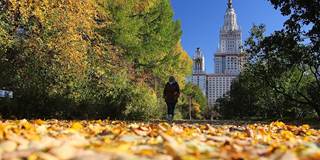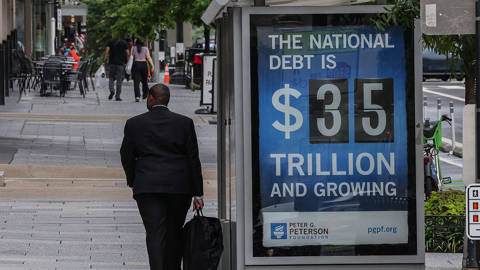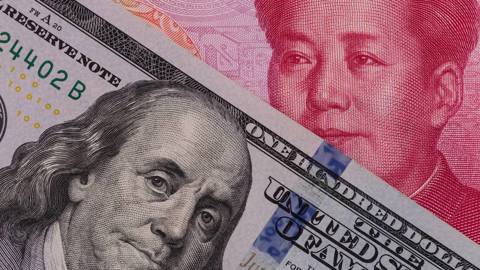With 70% of the world's population expected to live in cities by 2050, the need to address the dangers associated with "urban heat islands" and air pollution is more urgent than ever. Fortunately, there is a simple step that municipal leaders can take to reduce both extreme heat and air pollution: plant more trees.
WASHINGTON, DC – Last May, I had the dubious fortune of visiting Mumbai, India during the city’s hottest month on record. Temperatures remained at over 40°C (104°F) for days at time. The difference between standing in the shade of a tree and standing in full sunlight was like night and day.
Such heat waves are not merely uncomfortable. They pose a serious health threat – one that is often overlooked when addressing extreme weather.
In fact, heat waves account for more deaths than any other type of weather-related event, killing more than 12,000 people worldwide each year. The danger is particularly pronounced in cities, where the “urban heat island” effect results in temperatures as much as 12°C higher than in less-developed areas nearby. And the issue is not confined to tropical cities like Mumbai. In August 2003, a devastating heat wave across Europe killed more than 3,000 people in Paris alone.
Making matters worse, cities tend to have higher rates of air pollution, especially fine particulate matter (PM) resulting from the combustion of fossil fuels and biomass, which contributes to up to three million deaths every year. For many city residents, the greatest health and safety threat is the air around them.
Already, the World Health Organization estimates that 92% of the world’s population is exposed to dangerous air pollution. Given rapid urbanization – up to 70% of all people will live in cities by 2050 – the rate of exposure to higher levels of pollution is rising rapidly.
But urbanization doesn’t have to create a health crisis. In fact, there is a beautifully simple action that municipal leaders can take to reduce both extreme heat and air pollution: plant more trees.
Trees and other vegetation naturally cool the air around them by shading surfaces and releasing water vapor. Moreover, their leaves act as filters, reducing PM levels in the surrounding 30 meters (nearly 100 feet) by as much as one-quarter. It is a one-two punch of environmental action.
My organization, The Nature Conservancy, has carried out a study of 245 cities around the world that stand to benefit from tree-planting initiatives, estimating their potential return on investment in terms of both temperature and PM. Given that the most significant effects of trees are highly localized, we found that densely populated megacities in Pakistan, India, and other parts of South and Southeast Asia would benefit most.
The highly localized effects of trees mean that planting them can provide highly targeted benefits, even in cities that ostensibly have plenty of green space. Consider Louisville, Kentucky.
With its lush parks and shaded neighborhoods, it would appear to have little in common with Mumbai or Karachi. Yet there are neighborhoods in Louisville with minimal tree cover, making the city one of the fastest-growing heat islands in the United States – and prompting The Nature Conservancy to initiate a targeted tree-planting effort.
Countless other neighborhoods worldwide could benefit from similar initiatives. Areas with vulnerable populations – near schools and hospitals, for example – are particularly good candidates for such efforts. Trees can even be used as a natural screen against pollution from highways or industrial areas.
Worldwide, $100 million of annual investment in tree-planting initiatives could provide as many as 68 million people with significant reductions in PM levels, while also providing 77 million people a reduction of 1°C in air temperature. An investment equivalent to $4 per person could save 11,000-36,000 lives annually and reduce adverse health effects for tens of millions of people.
That return on investment is comparable to estimates for other strategies, such as industrial scrubbers, limits on automobile traffic, and use of light-colored building materials that absorb less heat. All of these strategies have a part to play; trees alone won’t solve all of our heat and air-quality issues. But only tree-planting addresses both urban heat and air pollution.
Trees also offer a host of other benefits for cities. They provide habitat for wildlife, reduce storm-water runoff, and sequester carbon from the atmosphere, which helps to mitigate climate change. There is also a growing body of research showing that exposure to trees and other vegetation has a positive effect on mental health, especially for children. All of these co-benefits speak to the wisdom of greater investment in trees and urban green infrastructure such as parks and rain gardens.
The Sustainable Development Goals, which include a dedicated goal for sustainable cities, have established rising temperatures and urban air quality as urgent global issues. Both will be discussed extensively at the annual United Nations Climate Change Conference, which starts next week in Marrakech, Morocco. But these are also local issues, experienced very differently in each city – and even in each neighborhood.
As global action on climate change and sustainability moves forward, municipal leaders can take their own steps, starting with a targeted, localized, and replicable tree-planting strategy that improves the health and wellbeing of their residents. Time to get planting.










WASHINGTON, DC – Last May, I had the dubious fortune of visiting Mumbai, India during the city’s hottest month on record. Temperatures remained at over 40°C (104°F) for days at time. The difference between standing in the shade of a tree and standing in full sunlight was like night and day.
Such heat waves are not merely uncomfortable. They pose a serious health threat – one that is often overlooked when addressing extreme weather.
In fact, heat waves account for more deaths than any other type of weather-related event, killing more than 12,000 people worldwide each year. The danger is particularly pronounced in cities, where the “urban heat island” effect results in temperatures as much as 12°C higher than in less-developed areas nearby. And the issue is not confined to tropical cities like Mumbai. In August 2003, a devastating heat wave across Europe killed more than 3,000 people in Paris alone.
Making matters worse, cities tend to have higher rates of air pollution, especially fine particulate matter (PM) resulting from the combustion of fossil fuels and biomass, which contributes to up to three million deaths every year. For many city residents, the greatest health and safety threat is the air around them.
Already, the World Health Organization estimates that 92% of the world’s population is exposed to dangerous air pollution. Given rapid urbanization – up to 70% of all people will live in cities by 2050 – the rate of exposure to higher levels of pollution is rising rapidly.
But urbanization doesn’t have to create a health crisis. In fact, there is a beautifully simple action that municipal leaders can take to reduce both extreme heat and air pollution: plant more trees.
BLACK FRIDAY SALE: Subscribe for as little as $34.99
Subscribe now to gain access to insights and analyses from the world’s leading thinkers – starting at just $34.99 for your first year.
Subscribe Now
Trees and other vegetation naturally cool the air around them by shading surfaces and releasing water vapor. Moreover, their leaves act as filters, reducing PM levels in the surrounding 30 meters (nearly 100 feet) by as much as one-quarter. It is a one-two punch of environmental action.
My organization, The Nature Conservancy, has carried out a study of 245 cities around the world that stand to benefit from tree-planting initiatives, estimating their potential return on investment in terms of both temperature and PM. Given that the most significant effects of trees are highly localized, we found that densely populated megacities in Pakistan, India, and other parts of South and Southeast Asia would benefit most.
The highly localized effects of trees mean that planting them can provide highly targeted benefits, even in cities that ostensibly have plenty of green space. Consider Louisville, Kentucky.
With its lush parks and shaded neighborhoods, it would appear to have little in common with Mumbai or Karachi. Yet there are neighborhoods in Louisville with minimal tree cover, making the city one of the fastest-growing heat islands in the United States – and prompting The Nature Conservancy to initiate a targeted tree-planting effort.
Countless other neighborhoods worldwide could benefit from similar initiatives. Areas with vulnerable populations – near schools and hospitals, for example – are particularly good candidates for such efforts. Trees can even be used as a natural screen against pollution from highways or industrial areas.
Worldwide, $100 million of annual investment in tree-planting initiatives could provide as many as 68 million people with significant reductions in PM levels, while also providing 77 million people a reduction of 1°C in air temperature. An investment equivalent to $4 per person could save 11,000-36,000 lives annually and reduce adverse health effects for tens of millions of people.
That return on investment is comparable to estimates for other strategies, such as industrial scrubbers, limits on automobile traffic, and use of light-colored building materials that absorb less heat. All of these strategies have a part to play; trees alone won’t solve all of our heat and air-quality issues. But only tree-planting addresses both urban heat and air pollution.
Trees also offer a host of other benefits for cities. They provide habitat for wildlife, reduce storm-water runoff, and sequester carbon from the atmosphere, which helps to mitigate climate change. There is also a growing body of research showing that exposure to trees and other vegetation has a positive effect on mental health, especially for children. All of these co-benefits speak to the wisdom of greater investment in trees and urban green infrastructure such as parks and rain gardens.
The Sustainable Development Goals, which include a dedicated goal for sustainable cities, have established rising temperatures and urban air quality as urgent global issues. Both will be discussed extensively at the annual United Nations Climate Change Conference, which starts next week in Marrakech, Morocco. But these are also local issues, experienced very differently in each city – and even in each neighborhood.
As global action on climate change and sustainability moves forward, municipal leaders can take their own steps, starting with a targeted, localized, and replicable tree-planting strategy that improves the health and wellbeing of their residents. Time to get planting.